Embrace Timeless Elegance: Your Ultimate Guide to French Farmhouse Style Decor
Do you dream of a home that perfectly blends rustic warmth with understated elegance? The captivating French farmhouse style offers just that – a timeless aesthetic that effortlessly marries the charm of old-world European living with the comfortable simplicity of country life. Far from being overly ornate or excessively rustic, this sought-after design trend strikes a beautiful balance, creating interiors that feel both invitingly cozy and sophisticatedly smart.
Its growing popularity in homes across the globe is a testament to its enduring appeal. Homeowners are increasingly drawn to the authentic, lived-in feel it provides, embracing elements like weathered natural materials, a serene color palette, and cherished vintage finds. This style transforms any space into a welcoming sanctuary, reflecting a history and character often missing in modern designs.
In this comprehensive guide, we will delve deep into the heart of French farmhouse decor, uncovering its core principles and essential components. Whether you’re looking to infuse a subtle hint of French country charm or embark on a full-scale renovation, discover how to bring this beloved style into every corner of your home, creating spaces that truly speak of comfort, history, and effortless beauty.
Understanding the Essence of French Farmhouse Style
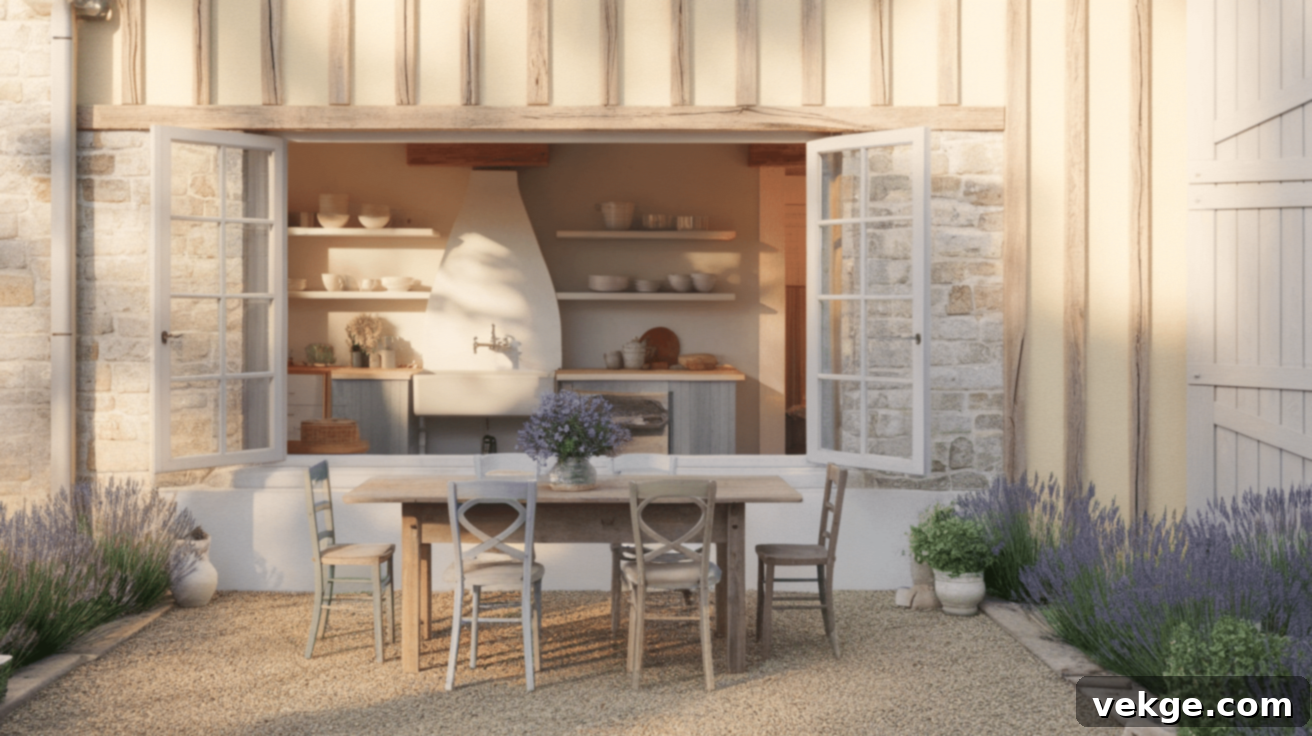
At its core, French farmhouse style is a harmonious blend of rustic comfort and a distinctly refined European sensibility. It’s a design philosophy deeply rooted in the practical, yet inherently beautiful, farmhouses that dot the picturesque French countryside. These homes were built by families using readily available local materials, prioritizing functionality while never sacrificing an innate sense of charm and grace. The result is a style that feels authentic, lived-in, and deeply connected to its natural surroundings.
Key characteristics of authentic French farmhouse interiors include a pervasive use of natural, often weathered, materials such as aged wood, raw stone, and wrought iron. These elements evoke a sense of history and permanence, reflecting the enduring quality of rural French architecture. Furthermore, the style champions the integration of antique and vintage furniture pieces, each telling a story of its past and adding unparalleled character to a space. These aren’t just decorative items; they are cherished heirlooms that contribute to the layered, collected feel.
The color palette is another defining feature, typically consisting of soft, muted, and neutral tones. Think creamy whites, gentle grays, serene blues, and understated greens, all of which create a tranquil and timeless backdrop. This approach allows the textures and forms of the furniture and accessories to truly shine.
It’s important to differentiate French farmhouse from its American counterpart. While both share a love for rustic elements, French farmhouse introduces a layer of subtle sophistication. American farmhouse often leans towards more industrial accents, starker lines, and a plainer aesthetic, sometimes incorporating bolder black and white contrasts. In contrast, French farmhouse embraces softer forms, more intricate carved details on furniture, elegant curves, and a generally more polished finish, even within its rustic context. It’s less about raw industrialism and more about a gentle, organic elegance.
Essential Elements for Mastering French Farmhouse Decor
To truly capture the coveted French farmhouse aesthetic in your home, it’s crucial to focus on a few fundamental design pillars. These core elements are what give the style its distinctive charm, creating that perfect balance of inviting country comfort and understated European grace.
Embracing Natural Materials
The French farmhouse style is deeply connected to nature, drawing inspiration and materials from the earth itself. The goal is to bring the organic beauty of the outdoors inside, fostering a sense of warmth, authenticity, and enduring quality. When incorporating natural materials, consider:
- Aged Wooden Beams: Exposed wooden ceiling beams, especially those with visible age and character, add architectural interest and a rustic foundation to any room.
- Stone Accents: Whether it’s a solid stone fireplace, a feature wall, or even stone flooring, this material grounds the space, offering a cool, solid counterpoint to softer textures.
- Soft Linens and Cottons: Prioritize natural, breathable fabrics like linen and cotton for curtains, upholstery, and bed linens. Their slightly crinkled, relaxed appearance contributes to the effortless elegance.
- Wrought Iron: Introduce the strength and traditional craftsmanship of wrought iron through lighting fixtures, bed frames, curtain rods, or decorative accents. Its dark, sturdy presence adds a touch of historical charm.
- Terracotta and Ceramic: Simple, unglazed terracotta pots or handmade ceramic dishes reinforce the earthy, artisanal feel.
These natural elements not only connect your home to the land but also tell a story. Imagine a large, rustic wooden dining table, its surface bearing the gentle marks and scratches of countless family meals and gatherings over generations.
A Serene and Neutral Color Palette
The color scheme in French farmhouse design is purposefully calm, soothing, and timeless. It aims to create an atmosphere of tranquility and openness, serving as a gentle backdrop that allows the textures and unique furniture pieces to truly shine. Focus on:
- Warm Creamy Whites: Opt for off-whites and creams over stark, brilliant white. These shades infuse a room with warmth and softness, preventing it from feeling cold or sterile.
- Soft, Muted Grays: Ranging from light dove gray to a deeper charcoal, these subtle hues evoke the misty mornings of the French countryside and provide a sophisticated neutral base.
- Earthy Taupes and Beiges: These colors wonderfully complement aged wood tones and natural stone, creating an organic and cohesive feel.
- Faded Blues: Think of the gentle, worn color of old denim or the soft hue of a summer sky. Muted blues add a touch of color without overpowering the serene atmosphere.
- Subtle Greens: Drawing inspiration from garden herbs and olive groves, soft, muted greens bring an element of nature indoors, adding freshness and depth.
This carefully curated palette ensures that every room feels restful, cohesive, and effortlessly elegant, providing the perfect canvas for your collected treasures.
The Charm of Vintage and Antique Furniture
One of the most defining characteristics of French farmhouse style is its embrace of furniture with a rich history and visible patina. These aren’t just pieces of furniture; they are storytellers that add soul and personality to your home. Look for:
- Distressed Wooden Tables and Chairs: Pieces with chipped paint, visible grain, or a naturally worn finish evoke a sense of authenticity and longevity.
- Elegant Cabinets and Armoires: Often featuring graceful curves, delicate carvings, or simple glass fronts, these storage pieces add a touch of refined beauty.
- Ornate Mirrors: Large, framed mirrors with gilded or antiqued finishes reflect light and add a touch of old-world glamour, often becoming a focal point.
- Antique Wooden Chests or Trunks: These serve as both functional storage and character-rich accents, perfect for end tables or at the foot of a bed.
- Upholstered Seating with Patina: Sofas and chairs with timeless silhouettes, perhaps covered in linen or a subtle patterned fabric, often show signs of gentle wear, adding to their appeal.
The beauty lies in the imperfection and the feeling that these items have been lovingly collected over time, rather than purchased as a matching set. Each piece contributes to a layered, organic aesthetic that feels deeply personal.
The Art of Rustic Meets Refined
The true genius of French farmhouse style lies in its masterful ability to blend rough, earthy elements with more polished, elegant touches. This dynamic contrast prevents spaces from feeling either too rustic and unpolished or too formal and stiff. It’s about creating an intriguing visual tension that makes a room feel both approachable and sophisticated.
- Weathered Wood and Fine China: A rustic, unpolished wooden dining table serves as a stunning foundation for a setting of delicate porcelain plates and crystal glassware.
- Rough Stone and Soft Textiles: A rugged stone fireplace or wall gains immediate warmth and comfort when paired with luxurious linen curtains or smooth velvet cushions.
- Simple Cottons and Ornate Frames: Drape a textured cotton throw over a gracefully carved armchair, or pair plain linen slipcovers with a mirror featuring an elaborate, gilded frame.
- Earthenware and Crystal: Simple, handmade ceramic bowls filled with garden blooms can sit harmoniously next to an antique crystal vase, showcasing a blend of humble and grand.
- Practical Elements with Artistic Flourishes: Functional items like open shelving filled with everyday dishware can be elevated by beautiful antique art or a small, framed botanical print.
This thoughtful interplay of textures, finishes, and eras is what imbues French farmhouse interiors with their unique charm, creating spaces that are genuinely comfortable, profoundly inviting, and always visually captivating.
Room-by-Room French Farmhouse Decor Inspiration
Now that we’ve explored the foundational elements, let’s journey through your home, room by room, to discover how to infuse the charming French farmhouse style into every space. These practical ideas are adaptable, whether you reside in a historic country home or a modern urban dwelling.
The Heart of the Home: A French Farmhouse Kitchen
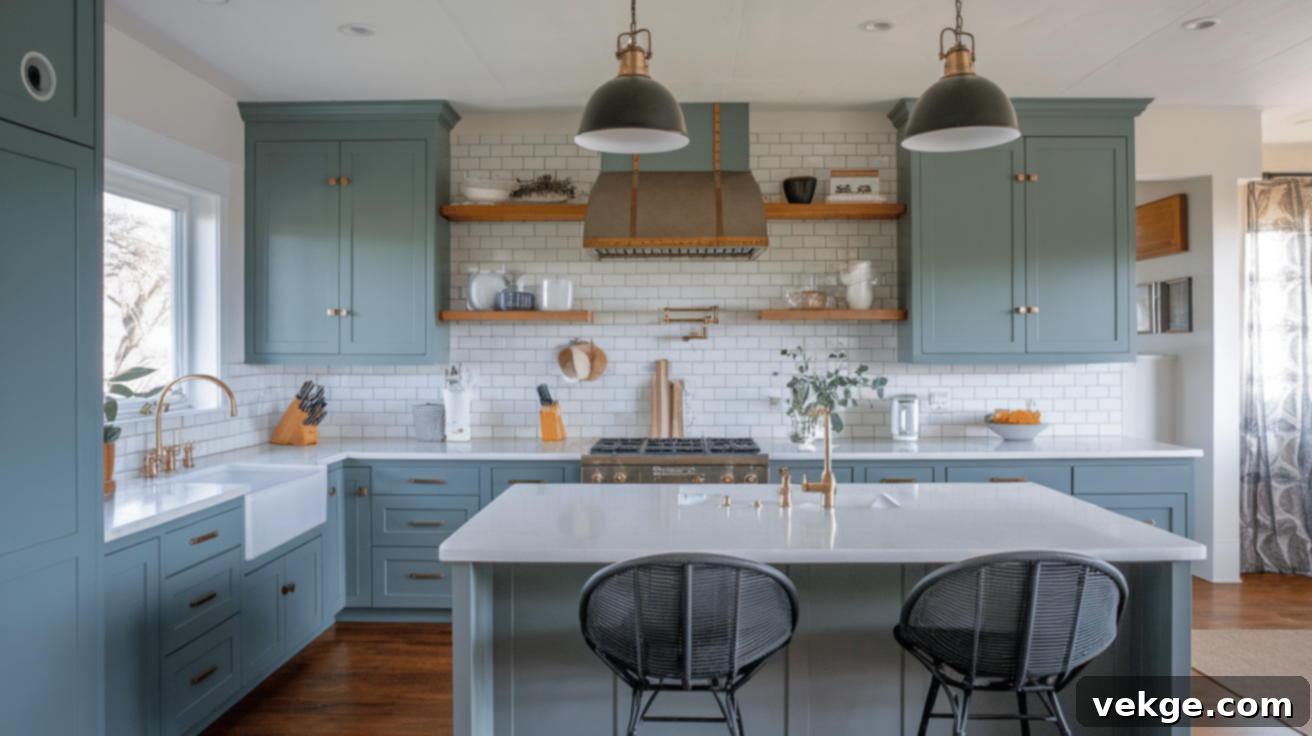
The kitchen is undeniably the soul of any French farmhouse, a place where practicality meets warmth and hospitality. To create this inviting atmosphere, prioritize elements that are both beautiful and functional:
- Open Shelving: Display your everyday white or cream dishware, handmade pottery, and glassware on open shelves, creating an inviting visual that also offers easy access.
- Farmhouse Sink: A large, deep apron-front sink, typically in white porcelain or fireclay, is a quintessential feature, perfect for handling everything from garden produce to large pots.
- Butcher Block Countertops: These add a rustic warmth and a tactile surface that ages gracefully, acquiring character with every meal prepared.
- Copper Accents: Hang gleaming copper pots and pans where they are visible and easily reachable, adding a classic touch of French culinary heritage.
- Central Wooden Table: Instead of a fixed island, consider a large, rustic wooden table as the focal point for food preparation, family meals, and casual gatherings.
- Fresh Herbs: Place small clay pots filled with fragrant herbs like rosemary, thyme, or basil on windowsills to bring life and scent into the space.
- Vintage Lighting: Opt for simple pendant lights or a classic wrought iron chandelier to illuminate the space with a soft, warm glow.
A Cozy and Inviting French Farmhouse Living Room
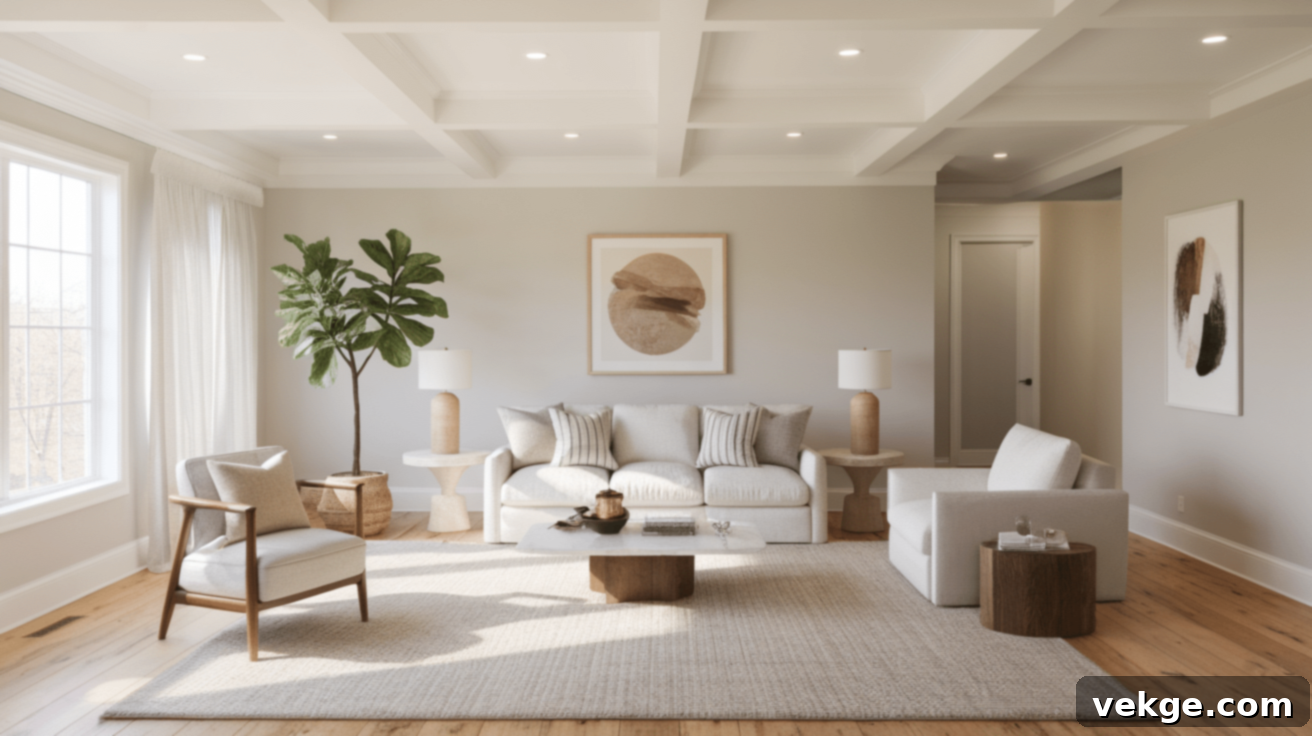
Your living room should feel like a welcoming embrace, designed for relaxation and comfortable conversation. Focus on creating a space that is both elegant and approachable:
- Linen or Cotton Slipcovered Sofas: Choose comfortable sofas and armchairs adorned with washable linen or soft cotton slipcovers in neutral tones. These are practical, maintain a relaxed elegance, and can be changed seasonally.
- Distressed Wooden Coffee Tables: Select sturdy coffee tables crafted from aged or reclaimed wood, which can withstand daily use while adding rustic charm.
- Tall Armoires or Cabinets: Incorporate large wooden armoires or glass-front cabinets for storing books, treasured collections, or media, offering both functionality and visual interest.
- Layered Textiles: Drape soft, neutral-colored throws and blankets over sofa arms and chairs, inviting guests to settle in. Layering different textures like knitted wool, soft cotton, and delicate linen adds depth.
- Faded Area Rugs: Introduce vintage or intentionally faded area rugs with subtle patterns. They add warmth, define seating areas, and bring in a touch of faded grandeur.
- Curated Decor: Display a thoughtful mix of old and new items – antique books, framed botanical prints, simple ceramic vases with fresh flowers, and personal mementos – creating a collected-over-time aesthetic.
A Serene French Farmhouse Bedroom Retreat

Transform your bedroom into a tranquil sanctuary where peace and comfort reign. The French farmhouse bedroom emphasizes softness, natural light, and serene simplicity:
- Feature Bedframe: Make the bed the focal point with an elegant iron bed frame, a beautifully carved wooden headboard, or a generously upholstered fabric headboard in a neutral linen.
- Layered Bedding: Create an inviting haven with layers of crisp white cotton sheets, soft duvets, and textured blankets in linen or wool. Mix and match textures for ultimate comfort and visual appeal.
- Soft Color Palette: Adorn pillows and accent throws in soothing shades of cream, light blue, pale green, or gentle taupe. Avoid overly bright or busy patterns.
- Subtle Patterns: If incorporating patterns, choose small floral motifs, delicate toile, or classic French stripe designs, used sparingly on accent pillows, a throw, or a single piece of artwork.
- Functional Bedside Tables: Flank the bed with antique wooden nightstands or small, simple tables, topped with good reading lamps that cast a warm glow.
- Natural Light: Keep window treatments light and airy, opting for sheer linen curtains that allow ample natural light to fill the room while offering privacy.
A Refreshing French Farmhouse Bathroom Escape
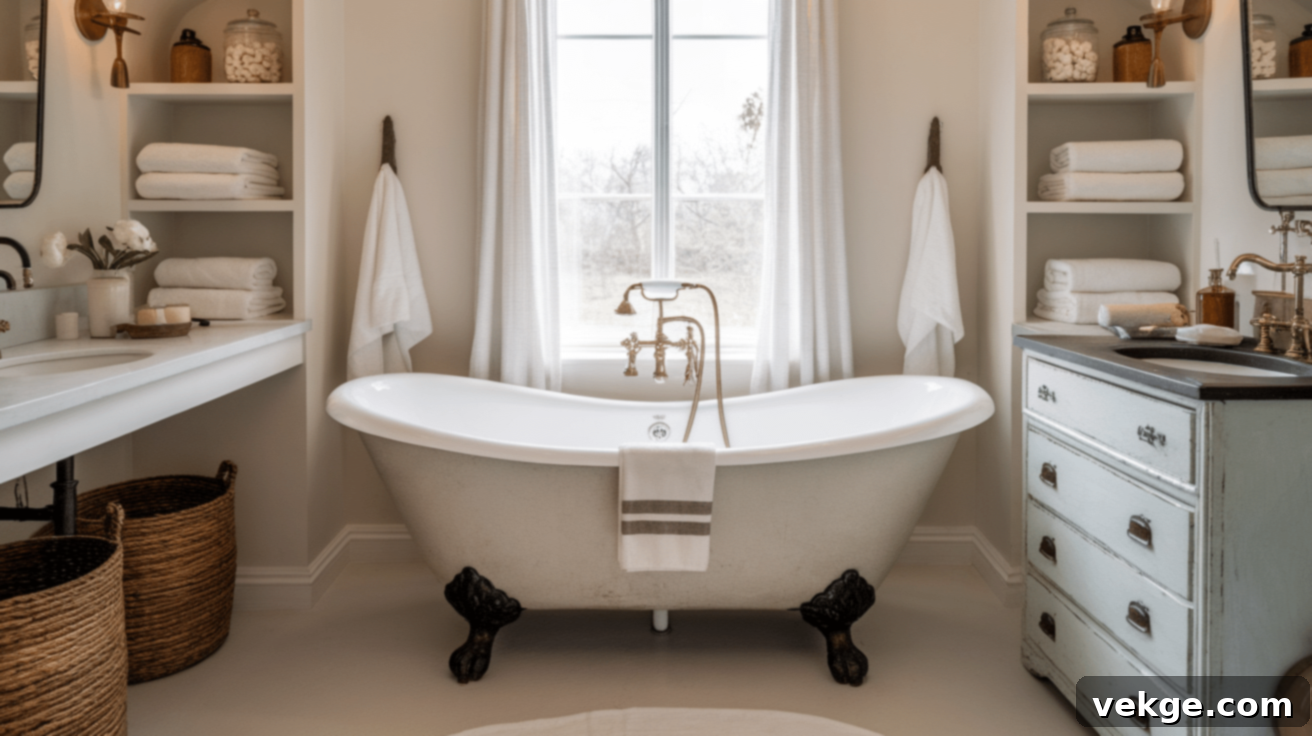
Even your bathroom can become a luxurious French country retreat, blending functional necessities with elegant, vintage-inspired details:
- Freestanding Bathtub: A clawfoot or pedestal tub with graceful curves and feet is often the star of a French farmhouse bathroom, evoking a sense of classic indulgence.
- Characterful Vanity: Repurpose an antique dresser or console table as a unique vanity, or choose a basin sink mounted on elegant legs for an authentic, collected look.
- Warm Metal Finishes: Opt for faucets, showerheads, and hardware in classic finishes like aged bronze, brushed gold, or polished nickel to add a touch of timeless sophistication.
- Open Shelving for Linens: Stack neatly folded simple white towels or bundles of fragrant soaps on open wooden shelves, adding both practicality and a spa-like feel.
- Glass Jars and Woven Baskets: Use clear glass jars to store cotton balls, bath salts, or soaps, and incorporate woven baskets for discreet storage of larger items or dirty laundry, adding texture.
- Vintage Mirror: A beautifully framed mirror above the vanity, perhaps with a distressed or ornate frame, adds a focal point and reflects light, making the space feel larger.
Crafting the Authentic French Farmhouse Exterior and Garden
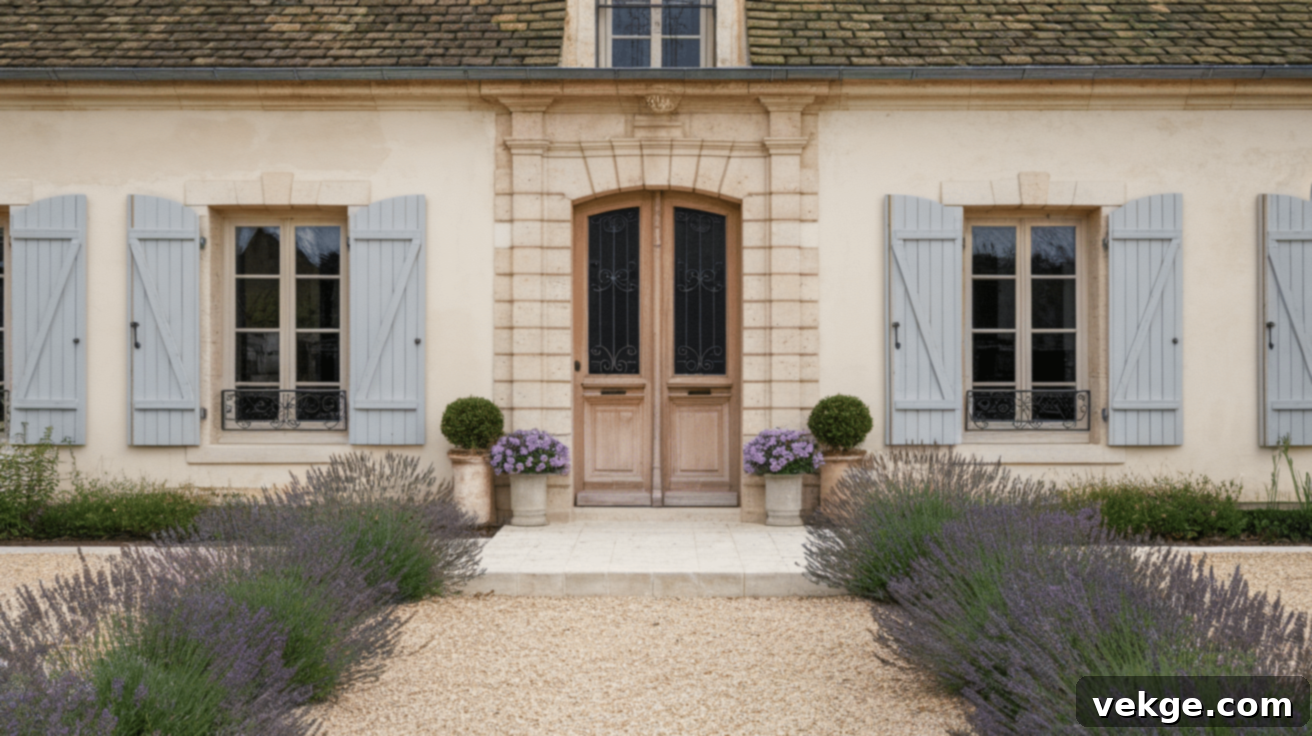
The exterior of a French farmhouse is just as critical to its overall charm and authenticity as the interior design. It sets the tone, offering a glimpse into the warmth and character that lies within. A truly captivating French farmhouse aesthetic seamlessly extends from the home’s outer architecture to its meticulously yet naturally cultivated garden and surrounding yard areas.
The construction materials traditionally used in genuine French farmhouses are heavily influenced by local availability, emphasizing durability and integration with the landscape. Walls are commonly crafted from robust stone or finished with stucco in inviting shades of soft cream, warm tan, or classic white. These materials not only contribute to the timeless visual appeal but also serve practical purposes, helping to regulate indoor temperatures throughout the seasons and requiring minimal maintenance over many decades.
Windows play a pivotal role in the French farmhouse exterior, often featuring traditional wooden shutters. These shutters are not merely decorative; they historically provided protection from harsh weather and helped to manage light and heat. Typically painted in charming, muted hues like soft blues, serene greens, or subtle grays, they offer a beautiful contrast against the light-colored walls, adding a distinct touch of provincial elegance.
Key exterior architectural elements and finishes to consider include:
- Inviting Front Doors: Solid wooden front doors, often featuring subtle glass panels or delicate wrought iron details, serve as a welcoming entry point.
- Classic Rooflines: Roofs are traditionally covered with terracotta clay tiles or natural slate, materials known for their longevity and ability to weather beautifully, acquiring a rich patina over time.
- Simple Ironwork: Hand-forged iron railings on steps, balconies, or window grates add a touch of refined craftsmanship without being overly ornate.
- Outdoor Lighting: Choose understated wall-mounted lanterns or simple hanging fixtures in wrought iron or aged bronze to provide soft illumination.
The garden and yard surrounding a French farmhouse, known as a ‘jardin,’ epitomize a relaxed yet thoughtfully arranged aesthetic. Far from formal, manicured lawns, these gardens exude an organic, slightly wild beauty. Instead of paved concrete, winding gravel paths invite leisurely strolls, leading through beds brimming with a casual mix of fragrant roses, aromatic herbs, and seasonal flowers.
Characteristic features of a French farmhouse garden often include:
- Fragrant Lavender: Rows or clusters of lavender plants are a quintessential sight, adding vibrant color, a captivating scent, and attracting pollinators.
- Simple Potted Plants: Terracotta pots of various sizes, filled with geraniums, hydrangeas, or small olive trees, are strategically placed to add vertical interest and bursts of color.
- Charming Sitting Areas: Create intimate nooks with an old metal bistro table and chairs or a wooden bench, perfect for enjoying a morning coffee or an evening aperitif.
- Productive Fruit Trees: Incorporate fruit trees like apple, pear, or cherry not only for their produce but also for their natural shade and seasonal beauty.
- Climbing Vines: Allow climbing roses, wisteria, or ivy to grow naturally over walls, pergolas, or trellises, softening architectural lines and adding a romantic touch.
Even if you don’t possess an expansive rural property, you can perfectly replicate this charming exterior and garden style in a smaller urban or suburban setting. The focus should be on creating a sense of natural beauty and inviting comfort. Prioritize plants that thrive in your local climate, incorporate durable natural materials, and establish one or two cozy outdoor sitting areas where you can relax and truly savor your French farmhouse-inspired surroundings.
Modern Interpretations: Blending French Farmhouse with Contemporary Living
The enduring appeal of French farmhouse style means it’s not confined to centuries-old homes in the European countryside. In fact, one of its greatest strengths is its adaptability, allowing it to seamlessly integrate with modern aesthetics to create spaces that feel both fresh and eternally chic. Contemporary homes can beautifully marry this classic, rustic charm with cleaner, more streamlined elements, resulting in interiors that are timeless yet perfectly suited for today’s lifestyle.
The secret to a successful modern French farmhouse look lies in achieving a thoughtful balance. The objective is to retain the inherent warmth, authenticity, and character of traditional French country design while introducing simpler forms, minimalist details, and a less cluttered approach that resonates with modern sensibilities. This often involves a conscious decision to favor fewer, more meaningful pieces over an abundance of decorative items, allowing each object to truly breathe and make a statement.
Key modern updates and approaches to consider for a contemporary French farmhouse:
- Streamlined Furniture with Antique Accents: Pair sleek, comfortable modern sofas and armchairs with a single, characterful antique wooden coffee table or a vintage chest. This juxtaposition creates visual interest and bridges eras.
- Crisp, Minimalist Walls: Opt for pristine white or very light neutral walls. These provide a clean, gallery-like backdrop that allows cherished vintage mirrors, bold artwork, or a few carefully chosen antique pieces to stand out and become focal points.
- Open-Concept Living, Defined Spaces: While embracing open floor plans for modern living, use furniture arrangement, area rugs, and subtle architectural features to define cozy conversation zones within the larger space.
- Updated Lighting: This is a prime area for modernization. Trade heavy, ornate fixtures for simple, elegant glass pendant lights above a kitchen island, sleek linear chandeliers over a dining table, or clean-lined floor lamps beside a vintage armchair.
- Mixed Materiality: Continue the “rustic meets refined” principle but with a modern edge. Think raw concrete floors with soft linen rugs, or polished stainless steel appliances paired with distressed wooden cabinetry.
- Functional Simplicity: Embrace built-in storage solutions that offer clean lines while maintaining the practical, organized feel inherent in farmhouse living.
Modern French farmhouse furniture selections often represent a thoughtful dialogue between different time periods and styles:
- Combine a robust, reclaimed wooden dining table with stylish, contemporary dining chairs made of metal or subtly upholstered fabric.
- Place a plush, minimalist sofa alongside a charming antique wooden side table, perhaps adorned with a modern ceramic lamp.
- Update a kitchen with new, efficient cabinetry but choose vintage-inspired hardware (like cup pulls or simple knobs) to infuse character.
- Integrate modern art prints or abstract paintings into a gallery wall that also includes antique botanical illustrations or framed postcards.
Ultimately, the most successful modern French farmhouse spaces skillfully retain the inviting comfort and authentic spirit of the original style while thoughtfully adapting its elements to suit the functionality and aesthetic preferences of contemporary living. It’s about a curated blend that feels both deeply rooted in history and effortlessly current.
DIY French Farmhouse Projects to Personalize Your Home
Achieving the charming French farmhouse aesthetic doesn’t necessarily require investing in expensive new furniture or decor. Many of the style’s most appealing elements can be introduced through thoughtful and rewarding DIY projects, offering a budget-friendly way to infuse character and a personal touch into your home. With just a few basic tools and materials, you can transform ordinary items into cherished pieces that evoke the warmth and history of a French country dwelling.
These hands-on projects are not only enjoyable but also allow you to create truly unique items that tell their own story, much like the collected treasures found in traditional French farmhouses.
Transforming Furniture with Chalk Paint
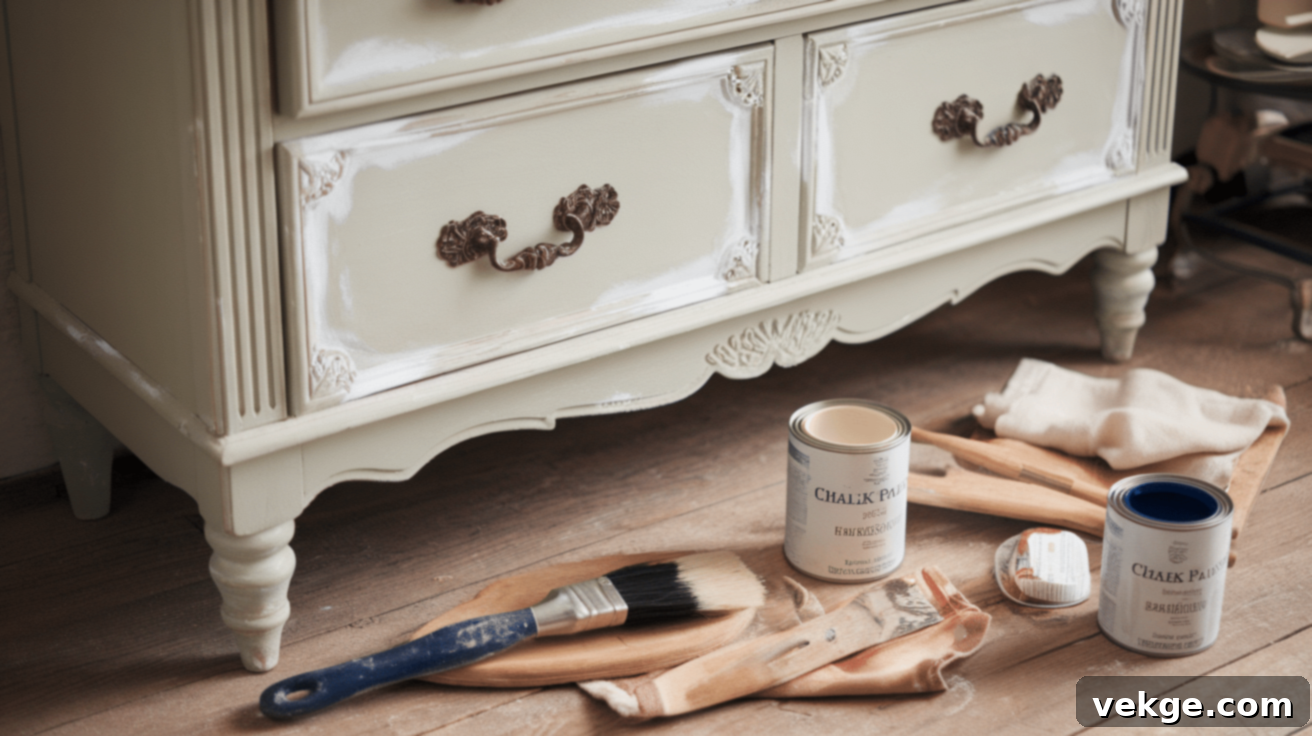
One of the most accessible and impactful DIY methods for embracing French farmhouse style is chalk painting old wooden furniture. Chalk paint is celebrated for its unique ability to provide a soft, matte, and slightly distressed finish that perfectly emulates the aged patina desired in this style.
Here’s a simple guide to chalk-painting a piece:
- Preparation: Begin by thoroughly cleaning the furniture piece to remove dirt and grime. Remove any existing hardware (knobs, pulls) if you plan to replace them or paint them separately. Unlike traditional paints, chalk paint typically requires no prior sanding or priming, saving significant time and effort.
- First Coats: Apply 1-2 thin, even coats of chalk paint. The beauty of chalk paint is its excellent adhesion to various surfaces. Allow each coat to dry completely according to the manufacturer’s instructions.
- Distressing (Optional): For an authentic aged look, once the paint is dry, use fine-grit sandpaper (120-220 grit) or a damp cloth to gently wear down paint on edges, corners, and areas that would naturally see wear over time. This technique reveals the original wood or previous paint color beneath, adding depth and character.
- Sealing: Finish the piece by applying a clear wax or a dark wax (for an even more antique effect) to protect the paint and deepen its finish. Buff the wax gently to achieve a subtle sheen.
This technique works wonders on old dressers, side tables, dining chairs, or even plain bookshelves. Opt for classic French farmhouse colors such as soft whites, creamy off-whites, muted grays, or delicate pale blues to achieve that quintessential provincial feel.
Crafting Authentic Distressed Wood Finishes
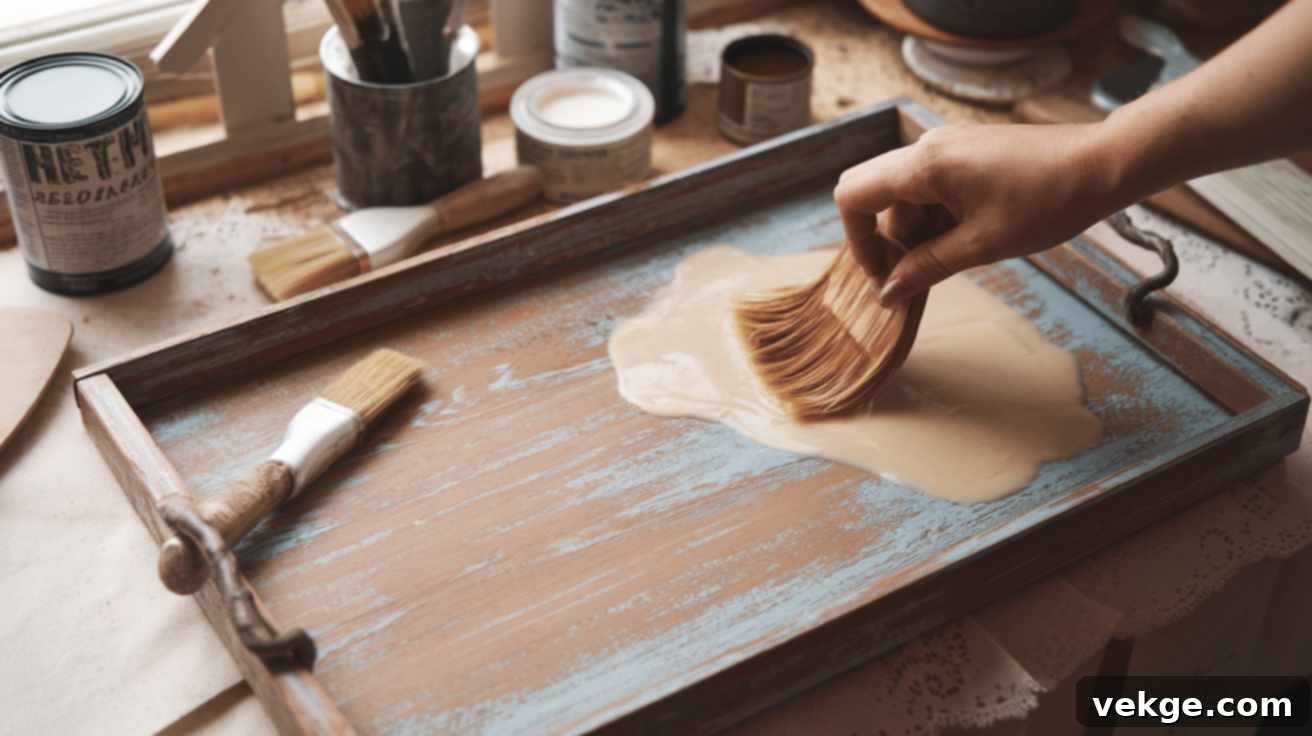
If you have new wooden items or pieces with a too-perfect finish, you can easily impart a sense of age and character through distressing techniques. Giving wood a worn, ‘loved’ appearance immediately aligns it with the storied aesthetic of genuine French farmhouse pieces.
Try this on unfinished wooden frames, plain shelves, serving trays, or even small furniture items:
- Base Preparation: Start with raw, unfinished wood, or thoroughly sand off any existing finish from a previously coated piece.
- First Paint Layer: Apply a base coat of your chosen color (e.g., a dark brown, a contrasting white, or a muted green) and allow it to dry completely. This will be the color that peeks through the top layer.
- Wax Application: Rub a white candle or a block of beeswax along the edges, corners, and other areas where natural wear would occur. This wax acts as a resist.
- Top Paint Layer: Apply a second coat of paint in a different, lighter color (e.g., a creamy white or pale gray) over the entire piece, including the waxed areas. Let this coat dry thoroughly.
- Distressing: Using fine-grit sandpaper or a steel wool pad, gently sand the areas where you applied the wax. The wax will cause the top layer of paint to easily lift, revealing the base color beneath and creating a beautifully aged, multi-layered effect.
- Seal (Optional): You can seal the finished piece with a clear varnish or wax for added durability.
This multi-layered distressing technique convincingly mimics wood that has been painted and repainted over many years, adding depth and narrative to your DIY projects.
Styling a Rustic Centerpiece or Curated Gallery Wall
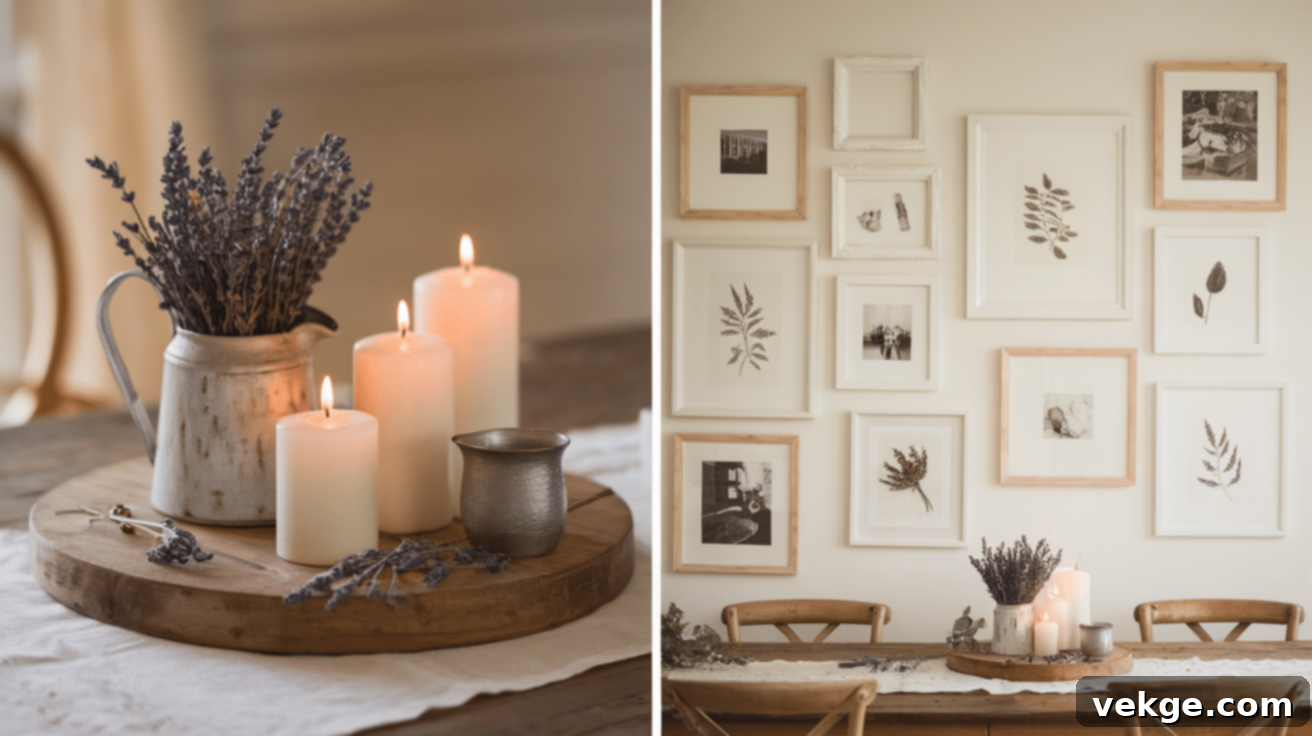
Sometimes, the greatest impact comes from thoughtfully arranging simple, everyday items. Creating a charming table centerpiece or a curated gallery wall are effective ways to introduce French farmhouse flair without significant expense, allowing your creativity to shine.
For an effortlessly chic French farmhouse centerpiece:
- Choose a Base: Start with a rustic foundation, such as a weathered wooden tray, a vintage cutting board, or a simple linen runner.
- Add Candles: Incorporate pillar candles of varying heights in classic white or ivory, placed in simple glass or metal holders, to create a soft, inviting glow.
- Natural Elements: Bring in elements from nature – a sprig of dried lavender, a small bouquet of wildflowers in a humble ceramic pitcher, or a bowl of fresh seasonal fruits.
- Metallic Touch: Include one or two understated metallic accents, like a small tarnished silver cup, a polished brass bell, or a tiny wrought iron birdcage, for a touch of refined contrast.
- Layer Textures: Place a folded linen napkin or a small crocheted doily underneath one of the items to add a subtle layer of texture.
For a captivating French farmhouse gallery wall, gather simple frames in a cohesive palette of white, cream, natural wood, or even antique gold:
- Classic Imagery: Fill frames with timeless black-and-white photographs of landscapes or still life.
- Botanical Prints: Include delicate sketches of flora and fauna, pressed plant specimens, or vintage botanical illustrations.
- Simple Art: Abstract line drawings or small, muted watercolor paintings work wonderfully.
- Personal Touches: Mix in old family photos or postcards from travel, especially if they have a vintage aesthetic.
These DIY projects empower you to gradually infuse your home with the coveted French farmhouse style, allowing you to enjoy the creative process and appreciate the unique, personal touches you’ve added along the way.
Embrace the Enduring Charm: Final Thoughts on French Farmhouse Style
In conclusion, cultivating an authentic French farmhouse ambiance within your home is a rewarding journey best achieved by embracing simplicity, purpose, and thoughtful curation. This beloved style doesn’t rely on extravagance or excessive ornamentation; rather, its beauty stems from a profound appreciation for natural materials, artisanal craftsmanship, and a history-rich narrative.
The true artistry lies in selecting pieces that not only possess inherent beauty but also serve a practical function, reflecting the hardworking yet graceful spirit of traditional French country living. Infuse warmth and depth into your spaces by strategically layering diverse textures – juxtapose the ruggedness of weathered wood with the soft drape of linen, pair the tactile appeal of woven baskets with the subtle gleam of polished metal, and blend plush throws with the solid presence of handcrafted ceramics.
To successfully achieve this timeless aesthetic, keep these fundamental principles at the forefront of your design choices:
- Prioritize Quality and Authenticity: Opt for fewer, well-chosen items that are built to last and tell a story, rather than filling your rooms with disposable trends.
- Celebrate Natural Materials: Allow elements like stone, aged wood, wrought iron, and organic fabrics to be the undisputed stars of your decor, connecting your home to the natural world.
- Cultivate a Collected Aesthetic: Seamlessly integrate a thoughtful mix of vintage, antique, and new pieces. This layering creates a nuanced, lived-in feel that suggests a home accumulated with love over many years.
- Embrace a Serene Palette: Rely on soft, neutral colors to create a calming and cohesive backdrop, allowing textures and unique pieces to stand out.
- Blend Rustic and Refined: Master the art of contrast by pairing rough, earthy elements with delicate, sophisticated touches, creating visual interest and balance.
Ultimately, the most captivating French farmhouse homes are those imbued with personal significance. It’s the cherished family photograph in a simple wooden frame, the antique bread bowl passed down through generations, or the handmade quilt that truly makes a house a home. These personal touches are the soul of the style, creating spaces that are not just beautiful, but deeply resonant and truly yours.
We hope this comprehensive guide has illuminated the path to transforming your living spaces with the timeless elegance of French farmhouse style. For more inspiring ideas, helpful tips, and detailed guides to assist with your next home improvement project, we invite you to explore our website and discover a wealth of design possibilities.
